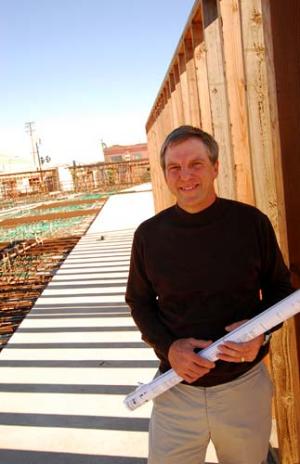Creating Truckee’s new downtown
TAHOE QUARTERLY
by Interview by Chaco Mohler
June 1, 2006
Rick Holliday never planned on becoming a key player in Truckee’s future, but that’s where fate has led him. With his wife Nancy, Holliday is owner and soon-to-be developer of 37 acres adjacent to downtown Truckee: the Rail Yard. His plans for this industrial property amount to a doubling of Truckee’s historic downtown.
Holliday, 52, is uniquely qualified for the task. His company, Holliday Development, specializes in redevelopment projects. He has turned old warehouses in San Francisco and Emeryville into desirable apartments, redeveloped the old Oakland rail yard into a neighborhood and converted Hamilton Airforce Base into a community.
Prior to becoming a developer, Holliday worked as a town manager, community development director and for the Federal housing Agency and helped start two nonprofits specializing in affordable housing solutions. He recently received an award from the California League of Conservation Voters, one of only three developers to receive such recognition. He has a master’s degree in city and regional planning from the University of California, Berkeley.
How did you get involved in the Tahoe area and with the Truckee Rail Yard?
The first time I came up here was in December of 1968 on a ski bus. The woman I ended up marrying was on the bus. When we had children, we came up and rented at Tahoe Donner before deciding we should buy a place there, which we did around 2000. Tahoe makes you feel good. You’re outdoors, you’re vibrant, you’re around people who tend to be friendly. As for becoming owner of the Rail Yard, like many things, it was totally unexpected. I started my private company in 2988, and I had been focusing on what is considered urban infill. We are about adaptive re-use and discovering emerging areas. If you’d asked me seven or eight years ago, “Do you think this will translated to a mountain town?” it wouldn’t have even crossed my mind.
So, what happened? I had bought four railroad properties in the Bay area, including a 30-acre site. It’s a very different challenge to a master-plan a railyard, but I enjoyed it because it drew on my planning background, my earlier days in the nonprofit world and my workforce housing experience. In November of 2004 I got a phone call from the Union Pacific representative that I had dealt with and he said, “I have good news and bad news. The good news is we’d like you to buy the rail yard in Truckee. The bad news is you’ve got to close and take title within six weeks.” I had about a three-week window to sort through everything.
So I went and saw Tony Lashbrook (Truckee Town Planner) and a light bulb sort of went on because he said, “The town really has had a desire to see the rail yard developed. The state has this grant money that we’ve applied for, and we want to see if we can get it done.”
So I said, “The railroad wants to sell me the property, but I’ve got to buy it the next six weeks. What should I do?”
“It’d be great if you solved our number one problem,” Tony said, “which is that the railroad would never sell it!” He gave me a lot of encouragement. So I thought, okay, now I can ask the most important person, my wife.
Her response was “Are you nuts? You have violated our one rule don’t develop in our backyard – and it’s our second home backyard! We’re supposed to go up there to relax. You just forgot that one.”
Fortunately, I had met Maia Schneider (former town council member). I knew how passionate she felt about trying to get the rail yard done and I realized that my wife and Maia have a lot in common. So I got them together. Nancy got a sense from Maia that this is an amazing community and that there was a real interest in doing something.
Finally Nancy said, “We should do this. It’s a good project.” So we bought it. Then I set about tying to convince the railroad to move their balloon track to the east. I thought we’d do it in a year: it’s been almost two, maybe three. But one of the new allies of the development was the Truckee Watershed Council; the beauty of moving the balloon track east is that Trout Creek can follow more of a natural path and you can have a flood management area.
So, we’ve come up with a plan to get 90 percent of what everybody wants, which is the creek restored and the balloon track moved. And the last 10 percent is going to be understanding how the buildings and the creek interface. One of the reasons why it’s taken a long time is that the railroad is going to have to deal with men testing the inside of the balloon and determining what level of clean up is desired there. We’ve done some tests, and I don’t think there’s anything ridiculously bad, like PCPs. There’s probably oil in the ground, but you can deal with that with known clean up methods.
What do you envision for the acres adjacent to the existing downtown?
One of the things people are saying, which I completely agree with, is “We want a seamless transition between Old Truckee and whatever’s going to be New Truckee.” After slowing traffic down to where it doesn’t feel dangerous to cross Donner Pass Road, the intersection between the two could be really great.
One thing I feel strongly about is that I want to build movie theaters. I don’t want to build a multiplex, but movie theaters do create a sense of place. In theaters you don’t want windows, so you take a block and embed the theaters in the middle of the building. Then you wrap the perimeter with retail. Some the interesting theaters that are getting built now have wine bars and places to get food. Arts theaters are doing well, and Truckee could use those as well as commercial theaters. I want maybe five theaters: two arts driven and three more commercial.
I’d like to do housing above that would be smaller and carry a lower price, either for rent or for sale. I’ve done projects in the Bay Area with spaces that sell to first time buyers for upwards of $300,000. I am leaning towards smaller because we need workforce housing. If you get people that are younger living above commercial then the downtown will get more energized. It’s younger people that have the energy that I always felt in Truckee.
Downtown merchants are concerned about high rents, so they’d like more retail to create competition and bring rents down. But they’re also concerned about the glut of new commercial. This won’t be a commercial spot where we have brand name tenants to get financed because this town doesn’t want that. As we work our way east, we’re trying to commercially define what would be the next logical step. It goes to the bigger issue about the way I’ve approached the site. I didn’t want to do it unless I had partners that were willing to let this morph at a pace that makes sense.
I get asked every week, “When are you going to start?” I’d like to start within 15 months.
The architecture of many of your projects has a decidedly modern look. Is that appropriate for Truckee?
The most important thing I try to do is fit in. there’s a project in Potrero Hill that we did that has some of the same qualities as Truckee, pretty eclectic. It’s surrounded by an intermediate school, weird Victorian Potrero houses, a condo complex and a railroad dump. To me it’s our best work. It was named runner up for the best development in the United States by the Urban Land Institute.
What people tell me is don’t try to make it look exactly like downtown. We don’t want this to be Virginia City II, but don’t disrespect the eclectic nature. So that makes it as challenging as anything we’ve done. I don’t have a good answer until I can show you my first building with the skin on it.
We need to pick up architectural themes that are here and still modern. A lot of the stuff that East West or Northstar is doing I like a lot – the whole mountain motif – but it’s not appropriate here. We need what I call the Truckee motif.
What are your top priorities for this project?
Going back to what Nancy and I said, our top priority is to be able to say that we contributed to making Truckee a better place. Every developer says that, but this one is more important because we really do want to be involved in the community.
The second is architecture. I want to get some sort of validation. The best is from locals who actually like it, or grow to like it, and then of course from professionals in your field.
The third, I’d like to see some workforce housing that doesn’t require subsidies.
Lastly, I’d like for it to be financially successful. Some people take on projects like this sort of as hobbies when they’ve become quite successful. But Nancy and I started Holliday Development borrowing $200,000 against a house we built by hand. We nearly went under in 1995 like many developers. Now we’re successful; we have the capacity to get good capital. But we want to prove that this kind of development is financially successful so that other towns can follow.
If you’d asked me three years ago, “What’s your favorite project,” I would have said West Oakland. If you ask me right now, it’s Truckee, because I’m in the part that I enjoy most. But there is one special piece to Truckee, because Nancy and I are developing in a place that we really care about and live in. for that reason, I hope that Truckee remains my favorite forever.



